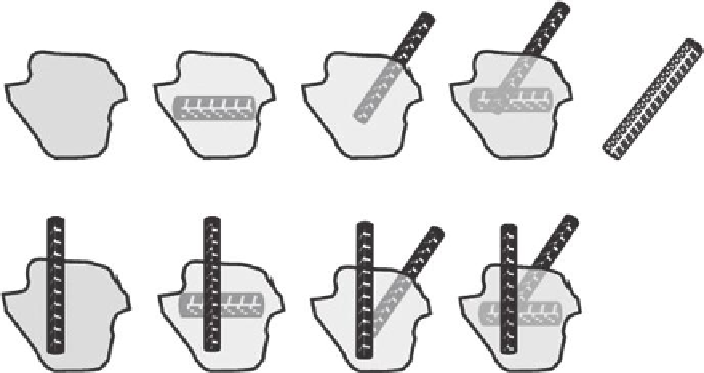Biomedical Engineering Reference
In-Depth Information
(a)
(b)
(c)
(d)
(e)
(f)
(g)
(h)
(i)
FIGURE 18.3
Various forms of material from an abrasive release event: polymer frag-
ments containing the following: (a) no multiwalled carbon nanotubes (MWCNTs); (b) and
(c) MWCNTs bonded to the polymer matrix fully encased (b) or protruding from the polymer
surface (c); (e) idealized unbound MWCNTs; (f) MWCNTs loosely adhered to the composite
surface; (d), (g), (h), and (i): combinations of (b), (c), and (f). For simplicity, MWCNTs are
portrayed as straight tubes, rather than as curved, twisted, and intertwined tubes typically
observed in actual MWCNT-polymer composites. (Adapted from Kaiser, D. et al. (2014),
Methods for the Measurement of Release of MWCNTs from MWCNT-Polymer Composites,
A Report of Task Group 1 of the NanoRelease Consumer Products Project, Submitted for
Steering Committee use in project monograph, personal communication.)
material Figure 18.3) and environmental transformation determine the potential
hazard. As mentioned for abrasion, it is relatively rare (although not quantified) to
observe release of free CNTs at least in initial release processes (Table 18.1).
18.3 ENVIRONMENTAL BEHAVIOR OF CNTs
The possibility of environmental persistence of CNTs coupled with matrix degrada-
tion may, however, result in as yet unrecognized exposure pathways to free CNTs.
Very little information is available on the behavior of CNTs in the environment due
to the difficulties in detecting these materials in natural environments. The meth-
ods most commonly used in CNT studies include radioactive labeling (Simon et al.
2010), detection of the catalysts used for CNT production (Maynard et al. 2004), or
thermal analysis (Lee et al. 2010), next to the commonly used electron microscopy.
CNTs are believed to be stable in the environment but some studies with enzymes
show a significant degradability (Zhao et al. 2011). Before this enzymatic degrada-
tion may occur, release of fibers from the matrix has to occur. Although this release
is possibly rare during the many initial release processes, it may take place by selec-
tive degradation of the matrix. This leads ultimately to the release of the CNT fibers.

Search WWH ::

Custom Search